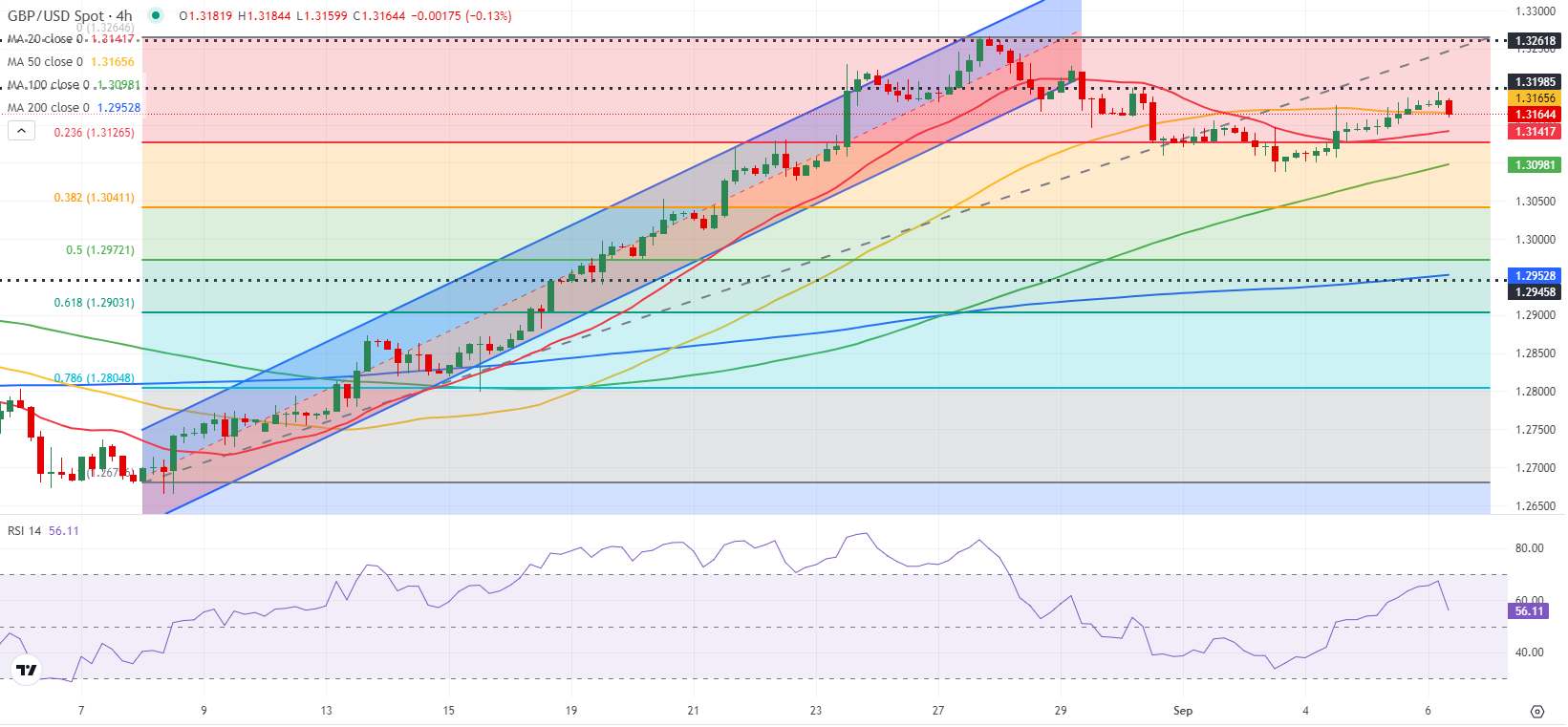- GBP/USD stays below 1.3200 after closing in positive territory on Thursday.
- The US Bureau of Labor Statistics will publish August labor market data on Friday.
- Investors expect an increase of 160,000 in Nonfarm Payrolls.
GBP/USD benefited from the selling pressure surrounding the US Dollar (USD) on Thursday and closed the second consecutive day in positive territory. After coming in within a touching distance of 1.3200, however, the pair lost its bullish momentum and started to retreat toward 1.3150.
British Pound PRICE This week
The table below shows the percentage change of British Pound (GBP) against listed major currencies this week. British Pound was the strongest against the Australian Dollar.
| USD | EUR | GBP | JPY | CAD | AUD | NZD | CHF | |
|---|---|---|---|---|---|---|---|---|
| USD | -0.53% | -0.29% | -2.31% | 0.09% | 0.43% | 0.29% | -0.86% | |
| EUR | 0.53% | 0.27% | -1.81% | 0.60% | 0.98% | 0.81% | -0.34% | |
| GBP | 0.29% | -0.27% | -2.09% | 0.32% | 0.68% | 0.57% | -0.63% | |
| JPY | 2.31% | 1.81% | 2.09% | 2.41% | 2.84% | 2.79% | 1.42% | |
| CAD | -0.09% | -0.60% | -0.32% | -2.41% | 0.38% | 0.19% | -0.95% | |
| AUD | -0.43% | -0.98% | -0.68% | -2.84% | -0.38% | -0.17% | -1.31% | |
| NZD | -0.29% | -0.81% | -0.57% | -2.79% | -0.19% | 0.17% | -1.14% | |
| CHF | 0.86% | 0.34% | 0.63% | -1.42% | 0.95% | 1.31% | 1.14% |
The heat map shows percentage changes of major currencies against each other. The base currency is picked from the left column, while the quote currency is picked from the top row. For example, if you pick the British Pound from the left column and move along the horizontal line to the US Dollar, the percentage change displayed in the box will represent GBP (base)/USD (quote).
On Thursday, the Automatic Data Processing (ADP) reported that payrolls in the private sector increased by 99,000 in August. This reading followed July's 111,000 increase and came in much below the market expectation of 145,000. With the initial reaction, the US Dollar (USD) came under selling pressure and allowed GBP/USD to push higher.
Later in the session, the US Bureau of Labor Statistics (BLS) will release labor market data for August. Investors expect Nonfarm Payrolls to rise 160,000.
Growing signs of a cooldown in the US labor market have been feeding into expectations for a large Federal Reserve (Fed) rate reduction at the September policy meeting. According to the CME FedWatch Tool, markets currently see a 43% chance of a 50 bps rate cut.
A disappointing NFP reading, near 100,000, could put additional weight on the USD's shoulders heading into the weekend and fuel another leg higher in GBP/USD. On the other hand, a positive surprise, with a print close to 200,000, could have the opposite effect on the USD's valuation and make it difficult for GBP/USD to find a foothold in the American session.
GBP/USD Technical Analysis
The Relative Strength Index (RSI) indicator on the 4-hour chart dropped below 60, reflecting a loss of bullish momentum. On the downside, immediate support is located at 1.3130, where the Fibonacci 23.6% retracement of the latest uptrend aligns. In case this support fails, 1.3100 (100-period Simple Moving Average (SMA), static level) could be seen as the next bearish target ahead of 1.3040 (Fibonacci 38.2% retracement level).
GBP/USD is likely to face first resistance at 1.3200 (static level). If the pair manages to clear this level, it could target 1.3260 (end-point of the uptrend) and 1.3300 (static level) next.
Nonfarm Payrolls FAQs
Nonfarm Payrolls (NFP) are part of the US Bureau of Labor Statistics monthly jobs report. The Nonfarm Payrolls component specifically measures the change in the number of people employed in the US during the previous month, excluding the farming industry.
The Nonfarm Payrolls figure can influence the decisions of the Federal Reserve by providing a measure of how successfully the Fed is meeting its mandate of fostering full employment and 2% inflation. A relatively high NFP figure means more people are in employment, earning more money and therefore probably spending more. A relatively low Nonfarm Payrolls’ result, on the either hand, could mean people are struggling to find work. The Fed will typically raise interest rates to combat high inflation triggered by low unemployment, and lower them to stimulate a stagnant labor market.
Nonfarm Payrolls generally have a positive correlation with the US Dollar. This means when payrolls’ figures come out higher-than-expected the USD tends to rally and vice versa when they are lower. NFPs influence the US Dollar by virtue of their impact on inflation, monetary policy expectations and interest rates. A higher NFP usually means the Federal Reserve will be more tight in its monetary policy, supporting the USD.
Nonfarm Payrolls are generally negatively-correlated with the price of Gold. This means a higher-than-expected payrolls’ figure will have a depressing effect on the Gold price and vice versa. Higher NFP generally has a positive effect on the value of the USD, and like most major commodities Gold is priced in US Dollars. If the USD gains in value, therefore, it requires less Dollars to buy an ounce of Gold. Also, higher interest rates (typically helped higher NFPs) also lessen the attractiveness of Gold as an investment compared to staying in cash, where the money will at least earn interest.
Nonfarm Payrolls is only one component within a bigger jobs report and it can be overshadowed by the other components. At times, when NFP come out higher-than-forecast, but the Average Weekly Earnings is lower than expected, the market has ignored the potentially inflationary effect of the headline result and interpreted the fall in earnings as deflationary. The Participation Rate and the Average Weekly Hours components can also influence the market reaction, but only in seldom events like the “Great Resignation” or the Global Financial Crisis.
Information on these pages contains forward-looking statements that involve risks and uncertainties. Markets and instruments profiled on this page are for informational purposes only and should not in any way come across as a recommendation to buy or sell in these assets. You should do your own thorough research before making any investment decisions. FXStreet does not in any way guarantee that this information is free from mistakes, errors, or material misstatements. It also does not guarantee that this information is of a timely nature. Investing in Open Markets involves a great deal of risk, including the loss of all or a portion of your investment, as well as emotional distress. All risks, losses and costs associated with investing, including total loss of principal, are your responsibility. The views and opinions expressed in this article are those of the authors and do not necessarily reflect the official policy or position of FXStreet nor its advertisers. The author will not be held responsible for information that is found at the end of links posted on this page.
If not otherwise explicitly mentioned in the body of the article, at the time of writing, the author has no position in any stock mentioned in this article and no business relationship with any company mentioned. The author has not received compensation for writing this article, other than from FXStreet.
FXStreet and the author do not provide personalized recommendations. The author makes no representations as to the accuracy, completeness, or suitability of this information. FXStreet and the author will not be liable for any errors, omissions or any losses, injuries or damages arising from this information and its display or use. Errors and omissions excepted.
The author and FXStreet are not registered investment advisors and nothing in this article is intended to be investment advice.
Recommended Content
Editors’ Picks

AUD/USD appreciates as US Dollar remains subdued after a softer inflation report
The Australian Dollar steadies following two days of gains on Monday as the US Dollar remains subdued following the Personal Consumption Expenditures Price Index data from the United States released on Friday.

USD/JPY consolidates around 156.50 area; bullish bias remains
USD/JPY holds steady around the mid-156.00s at the start of a new week and for now, seems to have stalled a modest pullback from the 158.00 neighborhood, or over a five-month top touched on Friday. Doubts over when the BoJ could hike rates again and a positive risk tone undermine the safe-haven JPY.

Gold downside bias remains intact while below $2,645
Gold price is looking to extend its recovery from monthly lows into a third day on Monday as buyers hold their grip above the $2,600 mark. However, the further upside appears elusive amid a broad US Dollar bounce and a pause in the decline of US Treasury bond yields.

Week ahead: No festive cheer for the markets after hawkish Fed
US and Japanese data in focus as markets wind down for Christmas. Gold and stocks bruised by Fed, but can the US dollar extend its gains? Risk of volatility amid thin trading and Treasury auctions.

Bank of England stays on hold, but a dovish front is building
Bank of England rates were maintained at 4.75% today, in line with expectations. However, the 6-3 vote split sent a moderately dovish signal to markets, prompting some dovish repricing and a weaker pound. We remain more dovish than market pricing for 2025.

Best Forex Brokers with Low Spreads
VERIFIED Low spreads are crucial for reducing trading costs. Explore top Forex brokers offering competitive spreads and high leverage. Compare options for EUR/USD, GBP/USD, USD/JPY, and Gold.
